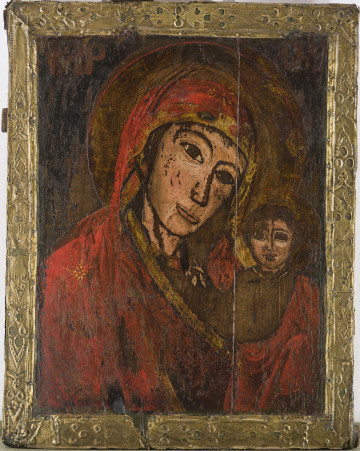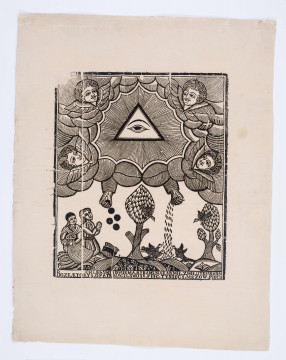
Holy Family
1801 — 1850
National Museum in Lublin
Part of the collection: Folk Art of the Lublin Region (17th–1st half of the 20th c.)
Folk woodcarving developed in the second half of the 18th and early 19th century. In the countryside and small towns devotional pictures were mainly distributed by monks of various congregations. The creators of wood engravings came from guilds and workshops were located in numerous pilgrimage places. Pilgrims bought images of miraculous Christological and Marian images or images of patron saints, believing that they brought divine protection to their families and households. Local pilgrimage sites such as Kodeń in Podlasie or Radecznica near Zamość were also popular. Secular or moral themes were rarely taken up.
Folk woodcuts were characterised by flatness, a strong contour line, often enriched with lines of modelling hatching, playing mainly a decorative role. The main figures were almost never placed on an empty background. Frequent filling motifs were folded draperies or clouds with angels placed on them; in this case, from the half-circle of clouds there leans the half-figure of God the Father with outstretched arms and the head surrounded by a triangular halo, and below there is a dove symbolising the Holy Spirit. The ornament used in the robes and as a background filling had a floral pattern, devoid of naturalistic features (lilies, roses, starry flowers). The faces of the figures, usually typified, without individual features, sometimes reflected pain and suffering (Christ figure). The composition could be complemented by inscriptions. Usually it was the name of the saint, sometimes a reference to the place where the miraculous image was kept, the date of execution and, most rarely, the details of the craftsman (here: OJAKSLICNAKOMPANIYAJEZUSJUZEFYMARIYA: RP1823,AH). In many cases there were spelling errors or incomprehensible abbreviations. It was due to mechanical reproduction of inscriptions by illiterate artists. Few left a trace of their initials, and only a few names are known.
The print of the woodcut from 1823 comes from the collection of Janusz Świeży. It forms a set with the print Oko Opatrzności [The Eye of Providence], from the same woodblock. It was made in 1923, in the number of 25 copies, by Wiktor Ziółkowski in Stanisław Dżała's Printing House "Pośpieszna" in Lublin. The board was lost in an estate in Volhynia during the Second World War.
Author / creator
Dimensions
cały obiekt: height: 30,5 cm, width: 36,5 cm
Object type
graphic print
Technique
woodcut
Material
Japanese paper
Creation time / dating
Creation / finding place
Owner
The National Museum in Lublin
Identification number
Location / status

1801 — 1850
National Museum in Lublin

1801 — 1900
National Museum in Lublin

1901 — 1921
National Museum in Lublin
DISCOVER this TOPIC
National Museum in Lublin
DISCOVER this PATH
Educational path